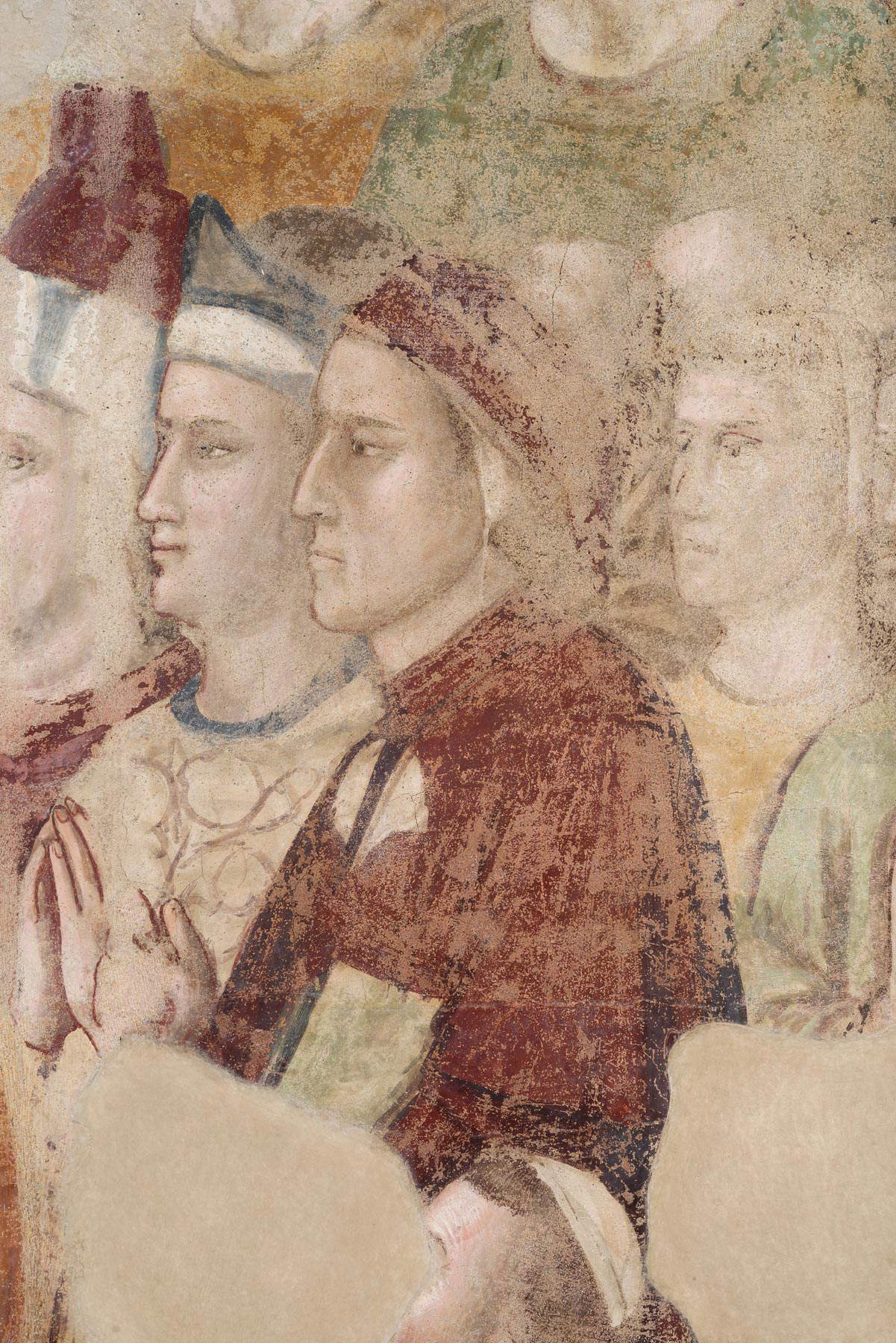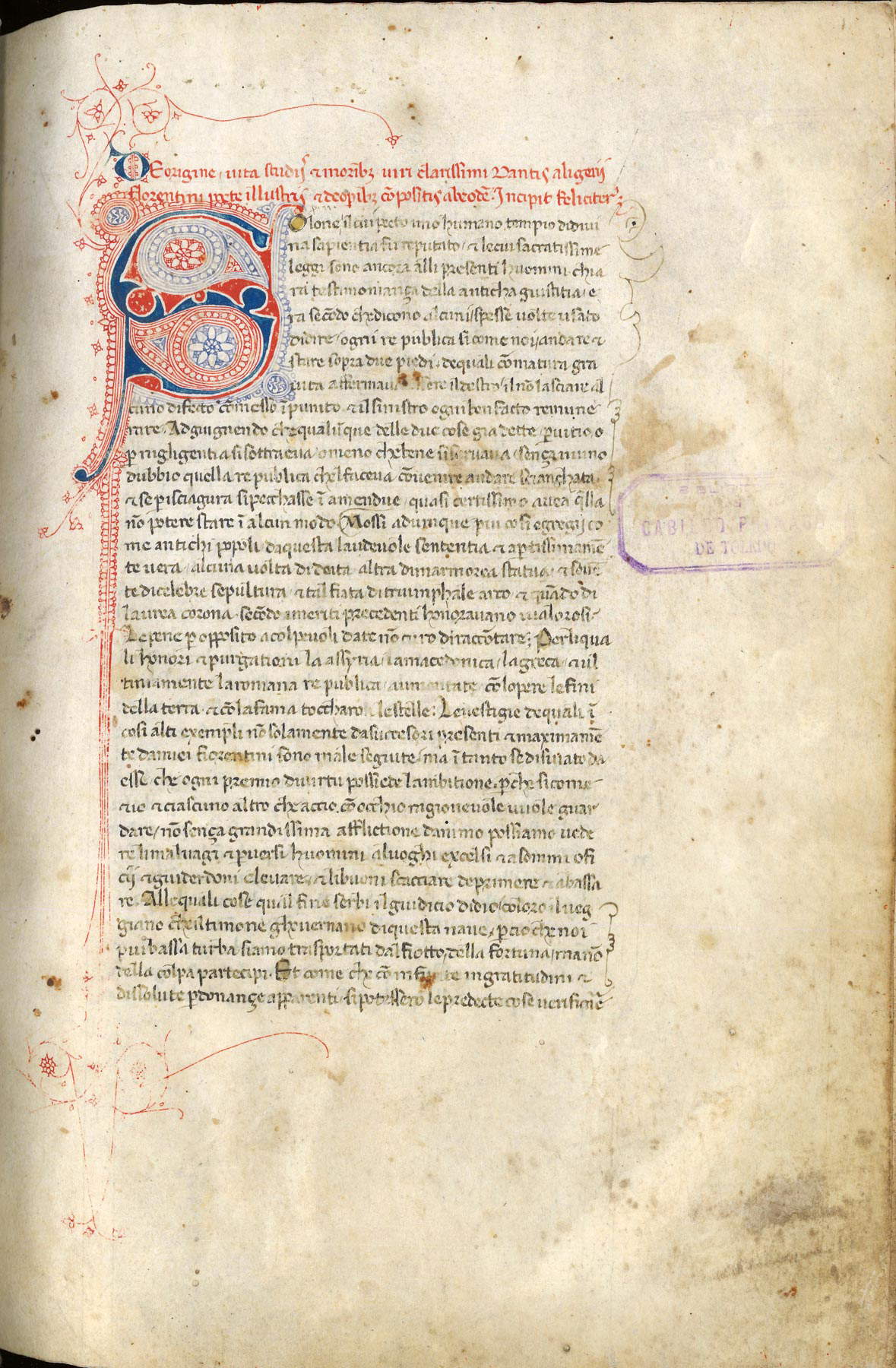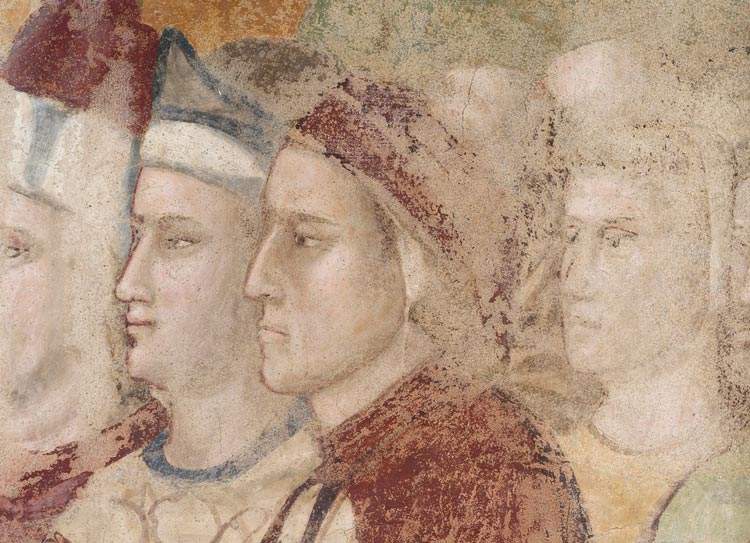The National Museum of the Bargello in Florence hosts, from May 11 to August 8, 2021, the exhibition Honorable and Ancient Citizen of Florence. The Bargello for Dante, an exhibition that brings Dante Alighieri (Florence, 1265 - Ravenna, 1321) to the public in a place that the poet himself frequented, on the 700th anniversary of his death. The title refers to the words that the Florentine historian, merchant and chronicler Giovanni Villani used to introduce the figure of Dante in his Nuova Cronica, written between 1322 and 1348, and which in fact stand as the first concise biography of the poet: “This Dante,” writes Villani, “was an honorable and ancient citizen of Florence of Porta San Piero, and our neighbor; and his exile from Florence was for the reason, that when Messer Carlo di Valos of the house of France came to Florence in the year MCCCI, and drove out the white part, as adietro ne tempi is mentioned, the said Dante was of the greatest governors of ourcity and of that part, well that he was Guelph; e però sanza altra colpa co la detta parte bianca fue cacciare e sbandito di Firenze, e andossene a lo Studio a Bologna, e poi a Parigi, e in più parti del mondo.”
The exhibition is dedicated to the relationship between Dante and Florence from the years immediately following the poet’s death until the 1950s, presenting the actors, initiatives, places and themes. The review curated by Luca Azzetta, Sonia Chiodo and Teresa De Robertis, professors at theUniversity of Florence, was created as part of an institutional collaboration between the Bargello Museums and the Departments of Letters and Philosophy (DILEF) and History, Archaeology, Geography, Art and Entertainment (SAGAS) of the University of Florence and counts among its scientific committee members expert philologists and art historians, such as Andrea De Marchi, Giovanna Frosini, Andrea Mazzucchi, Marco Petoletti and Stefano Zamponi. The exhibition has received a contribution and sponsorship from the National Committee for the Celebration of the 700th anniversary of Dante Alighieri’s death and the patronage of the 700 Dante Committee coordinated by the City of Florence.
The sponsoring institutions, which were instrumental in the realization of the event by lending a significant nucleus of manuscripts, include the Biblioteca Nazionale Centrale di Firenze, the Biblioteca Laurenziana and the Biblioteca Riccardiana.The Accademia della Crusca and the Opificiodelle Pietre Dure were key institutional interlocutors in the articulation of the scientific project. The exhibition, organized in collaboration with Firenze Musei, is accompanied by a short brochure (in Italian and English) and a rich catalog (in Italian and English) published by Mandragora. The volume, with contributions by twenty-six scholars from different disciplines, is enriched by color illustrations of the works on display and of the illuminated manuscripts and accompanied by a valuable final photographic atlas of the wall paintings of the Cappella del Podestà, which is an integral part of the exhibition.
 |
| Exhibition Hall |
 |
| Exhibition Hall |
 |
| Giotto and Giottesque School, Portrait of Dante (1334-1337; fresco; Florence, Bargello Museum, Cappella del Podestà) |
There are six sections that make up the exhibition: 1. The places of condemnation, the time of redemption; 2. Dante and the Comedy in Florence in the 1330s and 1340s; 3. Artists and copyists of the Comedy; 4. Reading Dante in Florence; 5. The construction of memory; 6. Documentary language in Florence after Dante. These six chapters feature some fifty objects including manuscripts and works of art from national and international libraries, archives and museums (from the Galleria dellAccademia in Florence, to the Biblioteca Nazionale Centrale in Florence, the Biblioteca Medicea Laurenziana and the Biblioteca Riccardiana, entities co-promoting the exhibition; from the Biblioteca Apostolica Vaticana to the Biblioteca Trivulziana in Milan; and again from the Bibliothèque nationale de France in Paris, theArchivo y Biblioteca Capitulares in Toledo and the Metropolitan Museum of Art in New York and others). The audience is taken on a journey that will allow them to meet the protagonists of the posthumous reconstruction of the relationship between Florence, Dante and his work in the second quarter of the 14th century. They are copyists, illuminators, commentators, readers, and vulgarizers whose professional and human histories are densely interwoven, restoring the image of a city that seems to transform itself into a diffuse scriptorium, at the center of which stands the Divine Comedy, and in which books circulate with abundance and new artistic and codicological solutions come to life precisely in relation to Dante’s poem.
Among the works on display is a masterpiece such as Pacino di Bonaguida’s Lignum Vitae, a panel arriving from the Galleria dellAccademia in Florence, which has exceptionally loaned it to the Museo Nazionale del Bargello: the work was created by the painter and miniaturist between 1310 and 1315. Pacino di Bonaguida has translated into images, in unusual detail, the themes of the literary text Lignum vitae, a treatise written by St. Bonaventure of Bagnoreggio in 1274. In the itinerary, the words that gravitate around the figure of Dante, in addition to showing themselves visually in the codices and works of art, are also transformed into sound and accompany the visitor. Thanks to an institutional agreement with the Fondazione Teatro della Toscana and the Associazione Oltrarno, which curated and produced a series of audio recordings, some of the texts, selected by the curators of the exhibition, resonate in the last section and contribute to animate Dante’s verses and the different registers of the Florentine language of the 14th century, through the voices of the young actors of the school directed by Pierfrancesco Favino.
But the Bargello National Museum itself is also part of the exhibition as the Dante site par excellence in Florence, and an ideal venue for the review that traces the relationship between Dante and his hometown: in the Sala dellUdienza of the then Palazzo del Podestà (now the Salone di Donatello), on March 10, 1302, the supreme poet was in fact sentenced to final exile; in the adjacent Podestà Chapel, only a few years later (between 1333 and 1337), Giotto, with his school, imposed his last pictorial masterpiece, still little known to the general public (i.e., the frescoes that adorn the chapel), and portrayed Dante’s face for the first time, including him among the ranks of the elect in Paradise. It was precisely around this portrait, the first known effigy of the father of the Italian language, that the memory-building process was thus outlined that would allow Florence to reappropriate the work and figure of Dante. The Chapel, where the frescoed face, an integral part of the exhibition itinerary, is located, has recently undergone diagnostic and conservation maintenance work on some parts of the Paradise, thanks to a grant from the Fondazione il Bargello onlus through ArtBonus and the institutional collaboration between the Bargello Museums and the Opificio delle Pietre Dure, which oversaw the diagnostic investigations and restoration. On the occasion of the exhibition it is also possible to see the new lighting and a preview of the new layout of the Chapel and the adjoining sacristy. The four showcases present are sufficient to understand the criteria according to which the collection of goldsmiths was organized, emphasizing the functions of this ornament, which, although precious in itself, was nevertheless primarily a liturgical and devotional tool. Prominent among the works displayed in the sacristy is the frieze signed by Andrea Pucci Sardi da Empoli and dated 1313. The frieze, a capital work of goldsmith’s art in Florence in the early 14th century, in dialogue with Giottesque inventions, is presented here after a delicate restoration by the Opificio delle Pietre Dure.
Honorable and ancient citizen of Florence. The Bargello for Dante was preceded by a series of seminars on Dante’s philology held at the Department of Letters and Philosophy of the University of Florence, open to the participation of students and scholars from all over Italy, and will be accompanied during 2021 by similar scientific and educational initiatives, including the series of free Dante for All workshops for children and young people, made possible thanks to a contribution from the Fondazione CR Firenze (which also contributed to the realization of the exhibition) to be held at the Bargello, and dedicated to the discovery of Dante and 14th-century Florence.
 |
| Andrea Lancia (copyist), Commedia con il commento dellAmico dellOttimo (New York, Pierpont Morgan Library, M.676, f. 47r: Lucifer at the bottom of Hell) |
 |
| Vat copyist (copyist), Master of Dominican effigies (illuminator), Commedia (Florence, Biblioteca Medicea Laurenziana, Pluteo 40.13, f. 25r: frontispiece of Purgatorio) |
 |
| Giovanni Boccaccio (autograph). Life of Dante and collection of works byAlighieri (Toledo, Archivo y Biblioteca Capitulares, Zelada 104.6, f. 1r: Trattatello in laude di Dante) |
“The exhibition, designed to allow differentiated levels of reading, is aimed not only at scholars but especially at the general public, with particular attention to children and young people,” says Paola DAgostino, Director of the Bargello Museums. “The institutional collaboration between the Bargello Museums and the University of Florence has been fundamental because of the pivotal role of the curators, professors from the University of Florence, and has also been a training opportunity for students, doctoral students and young scholars, involved in the project. In these three years we also wanted to involve different institutions and realities to create a shared project at several levels, between Florentine and Tuscan deccellency institutions. At a time of severe economic crisis, following the pandemic, I am particularly grateful to those who have financially supported this exhibition and to all those who have worked on the project and its realization, in the highest sense of service to the public.”
“An exhibition that reveals much about the life and work of the Supreme Poet, and on the 700th anniversary of his death, it could only be displayed in one of the most important Florentine Dante sites,” said Culture Councillor Tommaso Sacchi. It is therefore with great pleasure that we inaugurate this new piece in the narrative of and about Dante, made all the more precious at a time of general reopening of our places of culture after the dark forest of the pandemic.
“The exhibition,” explains Luca Azzetta, professor of Philology of Italian Literature at the University of Florence and curator of the exhibition, "reconstructs for the first time, in an original way and by combining the expertise of scholars from different disciplines, the dynamics by which Florence, a few years after Dante’s death, reappropriated his figure and the Commedia, which was immediately called the Dante by all. It is a unique episode in the history of Italian literature, on which depend the ways in which Dante has come down to us. Honorable and ancient citizen of Florence has not only an epigraphic value with respect to the narrative that the exhibition proposes, but also embodies the spirit that seems to have nourished the Florence of those years in its confrontation of the poet. Villani, in fact, emphasizes Dante’s ancient lineage and says he deserves that honor of which the banishment imposed on him had deprived him only because he was linked to a faction, the white side that history had wanted defeated. Villani, who is not silent about the intemperance and edginess of the poet’s character, writes these words in the 1940s, when reconciliation with the city in fact had taken place. The second part of the title, The Bargello for Dante, enhances the link between Dante and this palace where the podestà resided when the poet still lived in Florence. This place in fact transcends the biographical story and stands out for its symbolic value: in the Chapel of the Magdalene, Giotto, in an iconographic project now for the first time dated between 1333 and 1337, includes Dante among the ranks of the elect of Paradise, characterizing him with the attributes that define his nature as a poet. Today we know that the awe and fascination we share in was already of his earliest readers, those ancient citizens of Florence who have also passed on the poem and its memory for us.
"This is an exhibition approaches the subject from different points of view that result in very different works, such as the frescoes in the Bargello Chapel, Giotto’s last misunderstood masterpiece," says Stella Sonia Chiodo, professor of medieval history at the University of Florence and curator of the exhibition. “The research conducted on this occasion anticipates its initiation several years before the painter’s death and thus allows us to refer the elaboration of the iconographic program, based on a profound knowledge of Dante Alighieri’s Commedia, to the latter. The exhibition continues with illuminated and non-illuminated manuscripts, monumental but also very small painted panels: to deal with all this it was necessary to bring together different professionals (a Dante philologist, an art historian and a paleographer), and it would not have been possible otherwise. The exhibition reconstructs the fabric of Florentine culture in the 1920s and 1930s: to do this reliably we looked at this reality from different points of view but all on the same level.”
A major part of this exhibition," explains Teresa De Robertis, professor of paleography at theUniversity of Florence and curator of the exhibition, is assigned to the books: “about forty of them are on display, all of them exceptional in various ways, alongside a selected and equally exceptional draught of works of art, all chosen to illustrate the particular season Florence experienced in the name of its Poet, between about 1325 and 1350. Books are one of the ways through which Dante became a citizen of Florence once again: it is thanks to them that we can see today how the idea of a legitimately Florentine Dante came to be. And it is books that demonstrate the sincere passion of readers and Dante’s undisputed success in his city. In the history of medieval (and perhaps not only medieval) literature, the Commedia was a unique case of an immediate best-seller: the numbers tell us this, first of all (there are about seventy copies certainly produced in the years we are interested in that have come down to us: certainly many more, though we will never know how many, those that have been lost). We are then told by the monumental codices, which stand out for their quality: the collaboration between copyists and illuminators in defining a book model with clearly recognizable characteristics and a production that we could say was serial are concrete evidence of the path followed for Dante’s return to Florence.”“With the pandemic,” says Fondazione CR Firenze President Luigi Salvadori, “we have intensified our interventions in favor of children and their families. Part of this strategy is our support for the free workshops aimed at them that we have designed and supported on the occasion of this exhibition.”
“The Fondazione il Bargello - Onlus has been close to the Bargello National Museum since its inception as an Association in 1982,” says President Sergio Chiostri. “Since then, it has financially supported the Museum in implementing a range of initiatives to improve the usability of the works on display. This includes funding for the conservative revision of the Chapel’s wall paintings, designed by Giotto, and the restoration and securing of the Chapel’s windows.”
 |
| Copyist of Vat (copyist), Master of Dominican effigies (illuminator), Book of Biadaiolo (Florence, Biblioteca Medicea Laurenziana, Tempi 3, f. 58r: Florence welcomes the poor) |
 |
| Pacino di Bonaguida, Lignum vitae (Florence, Galleria dell’Accademia) |
 |
| Giotto and Giotto School, Paradise (1334-1337; fresco; Florence, Museo del Bargello, Cappella del Podestà) |
 |
| Dante and Florence: exhibition at the Bargello Museum reconstructs the relationship between the poet and the city |
Warning: the translation into English of the original Italian article was created using automatic tools. We undertake to review all articles, but we do not guarantee the total absence of inaccuracies in the translation due to the program. You can find the original by clicking on the ITA button. If you find any mistake,please contact us.